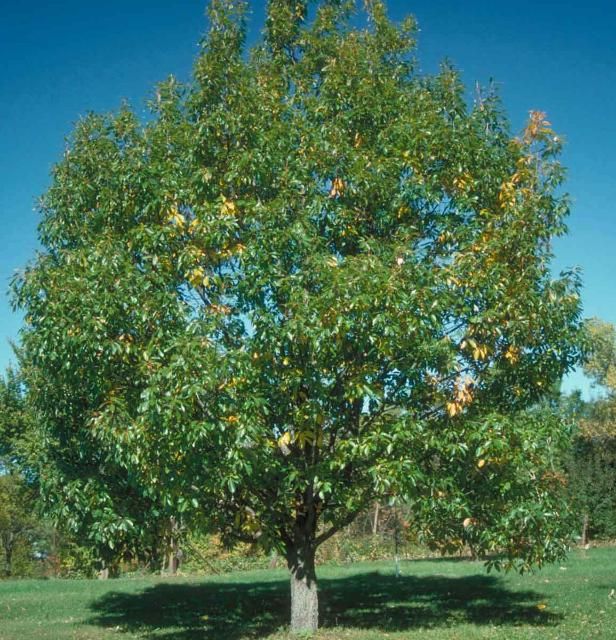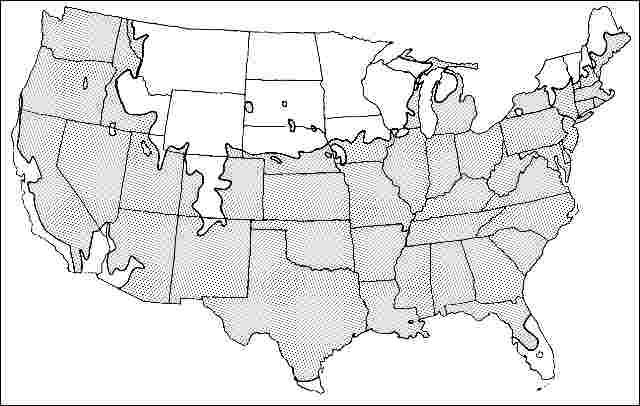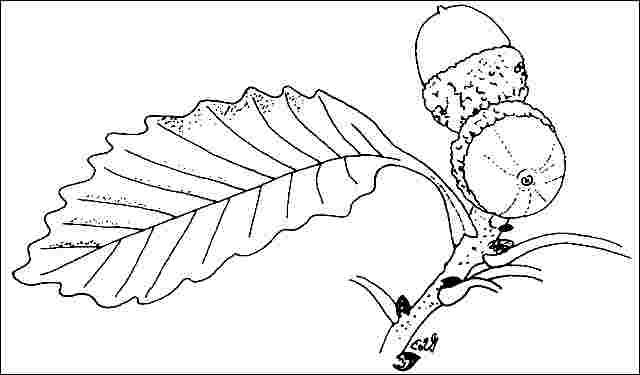Introduction
Chestnut oak is a deciduous, native tree which reaches 50 to 60 feet in height with an equal spread when grown in the open. It is capable of reaching to 100 feet in the woods. The glossy, green, 4- to 8-inch-long by 1.5- to 3-inch-wide leaves turn to yellow-brown or red-brown in fall before dropping. The large, 1.5-inch-long acorns which fall in October are particularly sweet-tasting, and are relished by many forms of wildlife, such as the grey squirrel, black bear, and white-tailed deer. The attractive dark brown to black bark is deeply ridged and furrowed.

Credit: Ed Gilman, UF/IFAS
General Information
Scientific name: Quercus prinus
Pronunciation: KWERK-us PRY-nus
Common name(s): Chestnut oak, rock oak, basket oak
Family: Fagaceae
USDA hardiness zones: 5A through 9A (Fig. 2)
Origin: native to North America
Invasive potential: little invasive potential
Uses: street without sidewalk; shade; parking lot island > 200 sq ft; tree lawn > 6 ft wide; highway median
Availability: somewhat available, may have to go out of the region to find the tree

Description
Height: 50 to 60 feet
Spread: 40 to 60 feet
Crown uniformity: symmetrical
Crown shape: round
Crown density: dense
Growth rate: moderate
Texture: coarse
Foliage
Leaf arrangement: alternate (Fig. 3)
Leaf type: simple
Leaf margin: crenate, undulate
Leaf shape: obovate, oblong
Leaf venation: pinnate
Leaf type and persistence: deciduous
Leaf blade length: 4 to 8 inches
Leaf color: green
Fall color: yellow, red, copper
Fall characteristic: showy

Flower
Flower color: brown
Flower characteristics: not showy
Fruit
Fruit shape: oval, round
Fruit length: .5 to 1 inch, 1 to 3 inches
Fruit covering: dry or hard
Fruit color: brown
Fruit characteristics: attracts squirrels/mammals; not showy; fruit/leaves a litter problem
Trunk and Branches
Trunk/bark/branches: branches don't droop; showy; typically one trunk; thorns
Pruning requirement: little required
Breakage: resistant
Current year twig color: brown, gray
Current year twig thickness: medium
Wood specific gravity: 0.66
Culture
Light requirement: full sun
Soil tolerances: clay; sand; loam; acidic; well-drained
Drought tolerance: high
Aerosol salt tolerance: unknown
Other
Roots: not a problem
Winter interest: no
Outstanding tree: no
Ozone sensitivity: unknown
Verticillium wilt susceptibility: resistant
Pest resistance: resistant to pests/diseases
Use and Management
Chestnut oak has been used for planting in parking lots and could be tested and used more for planting along streets and as a shade tree. The crown is dominated by one central trunk with lateral branches developing good attachments wiwth little pruning. Be sure to allow plenty of room for trunk expansion and root flare since this oak grows quite large.
Chestnut oak is naturally found on poor, dry, sandy, or rocky landscapes. Well adapted to planting along highway roadsides or in other areas were there will be no maintenance but not suited for clay soil or poorly-drained sites. The wood is very durable and hard.
Quercus michauxii (swamp chestnut oak), a closely related species, is lumped together by some botanists with Quercus prinus although they look quite different. Swamp chestnut oak grows taller, with platey, light grey bark and has similar cultural requirements.
Propagation is by seed.
Pests and Diseases
No pests or diseases of major concern other than gypsy moth. Variable oak and oak slug caterpillars can infest the tree although natural enemies usually provide control. Fall cankerworm has been a problem in some years. There are many other potential problems, although none serious.
Chestnut oak is susceptible to oak wilt.